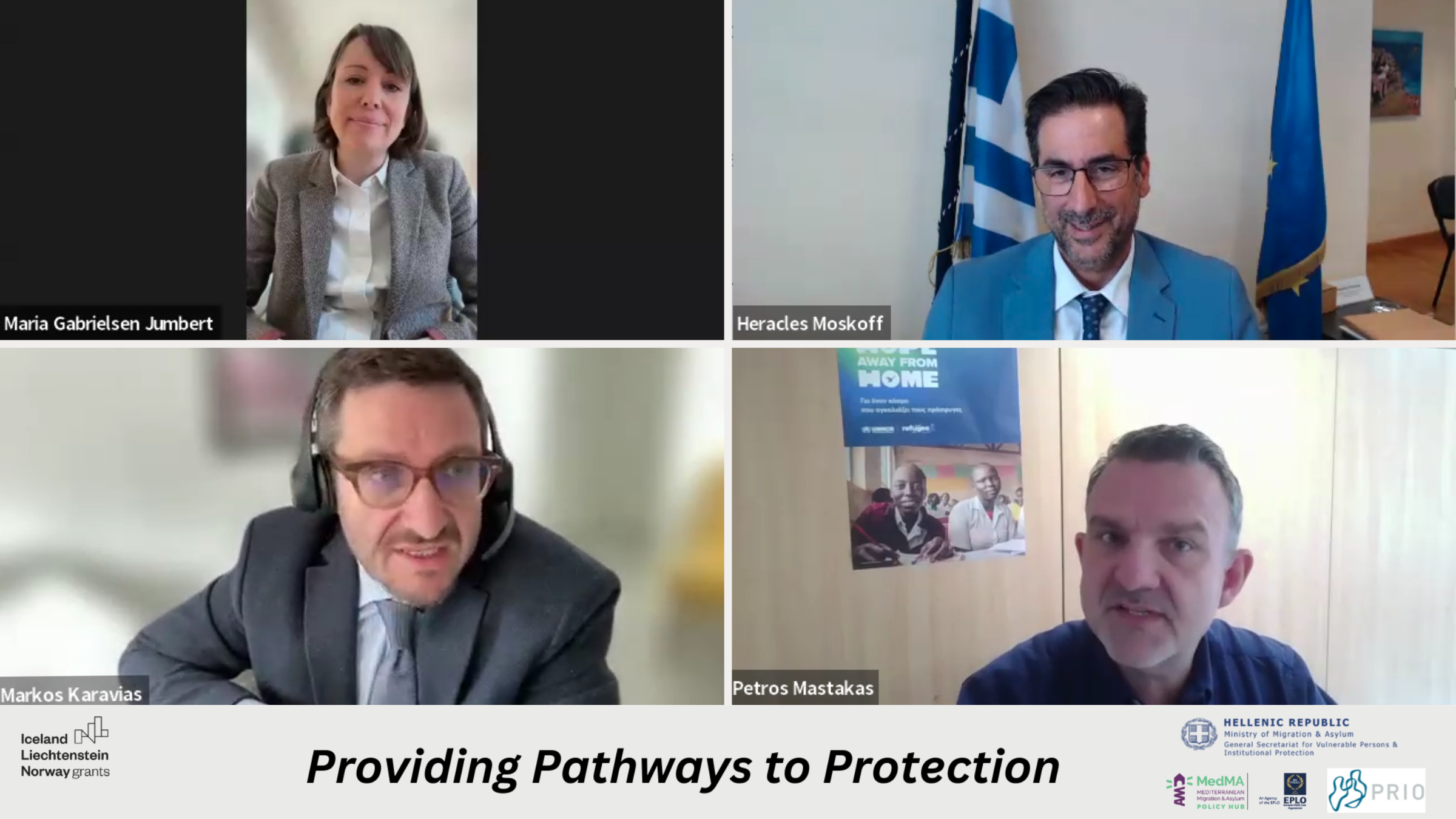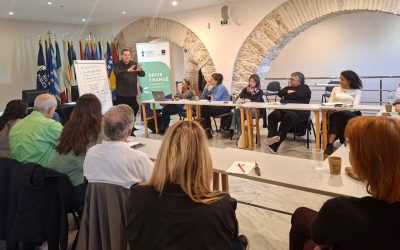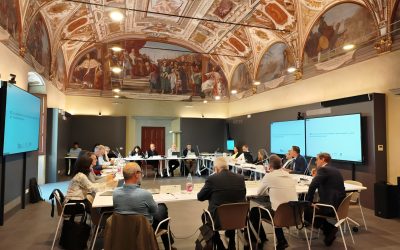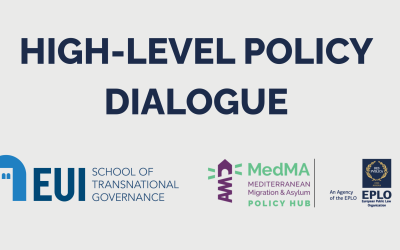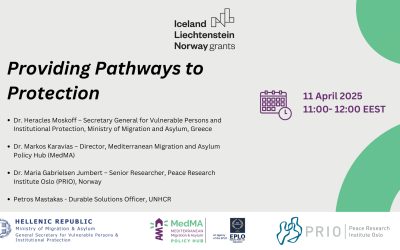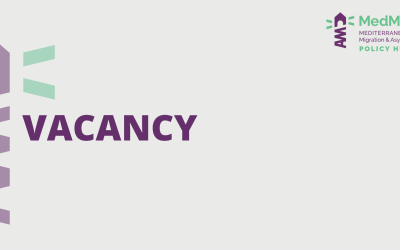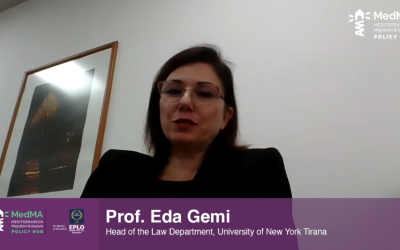Project Background and Context
On April 11, 2025, the Mediterranean Migration and Asylum Policy Hub (MedMA) hosted the final webinar of the project “Providing Pathways to Protection: Exchange of Expertise between Greece and Norway”. The project was implemented by the General Secretariat for Vulnerable Persons and Institutional Protection of the Ministry of Migration and Asylum in Greece, in cooperation with MedMA and the Peace Research Institute Oslo (PRIO), with co-funding from the EEA Grants 2014-2021 program and national funds. You may read the Policy Report here.
The webinar featured short interventions from key institutional and research partners:
- Heracles Moskoff, Secretary General for Vulnerable Persons and Institutional Protection, Ministry of Migration and Asylum, Greece
- Markos Karavias, Director, Mediterranean Migration and Asylum Policy Hub (MedMA)
- Maria Gabrielsen Jumbert, Senior Researcher, Peace Research Institute Oslo (PRIO), Norway
- Petros Mastakas – Durable Solutions Officer, UNHCR
Greece’s Current Approach and Challenges
Dr. Heracles Moskoff, Secretary General for Vulnerable Persons and Institutional Protection at the Ministry of Migration & Asylum in Greece, opened the webinar by highlighting the continued rise in global migration and refugee movements driven by conflicts in Ukraine, Gaza, and Syria, noting that most displaced people remain near their countries of origin. Dr. Moskoff explained that while Greece has shown political will through several ad hoc humanitarian admission initiatives-including the admission of Afghan women leaders in 2021, Ukrainian unaccompanied minors in 2022, and vulnerable children from Gaza in 2024- the country faces significant challenges.
Understanding the Need for Safe Pathways
Dr. Markos Karavias, Director of MedMA, emphasized the need for clarity on what pathways entail and how they can become operational. He highlighted that resettlement is one of the oldest tools in managing forced displacement, predating the rise of territorial asylum systems centered on refugee status determination.
“We need to define pathways and spell out the manners in which they are to become operational,” Dr. Karavias stated, adding that resettlement has been part of efforts to establish a common European asylum system since the early 2000s.
Dr. Karavias noted that Greece’s system of international protection has focused mainly on creating a functioning asylum and reception system, with resettlement remaining largely a non-issue in Greek migration policy. However, recent humanitarian admission initiatives show a potential shift in approach.
Norway’s Resettlement Model
Dr. Maria Gabrielsen Jumbert, Senior Researcher at PRIO, shared insights from Norway’s experience with resettlement, highlighting its longstanding commitment to the international resettlement system since after World War II, with a more structured approach emerging from the 1980s.
“Norway recognizes international resettlement as an important contribution to the international solidarity mechanisms, so that if all the states that can resettle refugees, this will alleviate the overall global pressures and needs for international protection,” Dr. Gabrielsen Jumbert explained.
She detailed Norway’s quota-based system, currently set at 500 refugees per year (down from previous years due to the high number of Ukrainians received since 2022), and explained the comprehensive process:
Dr. Gabrielsen Jumbert emphasized that this system allows Norway to plan rather than merely react to refugee situations, with civil society organizations providing complementary support to government-led efforts.
UNHCR Perspective on Global Needs and Safe Pathways
Petros Mastakas, Durable Solutions Officer at UNHCR, outlined the organization’s mandate to support durable solutions for refugees: voluntary repatriation, local integration, and resettlement, as well as complementary pathways such as humanitarian admission, family reunification, and education and employment opportunities.
Mastakas emphasized that the lack of safe pathways forces refugees to use smuggling networks, creating security threats and dangers for refugees. He identified four essential ingredients for successful implementation of safe pathways:
While acknowledging Greece’s efforts through ad hoc humanitarian admissions, Mastakas highlighted the need for a more systematic approach. He noted that Greece had once considered pledging about 200 resettlement slots under the EU resettlement scheme, a modest number compared to global needs but a starting point for building capacity
Key Recommendations
The project produced several key recommendations for Greece:
- Standardize a humanitarian admission mechanism within the framework of the EU Pact on Migration and Asylum, as a tool of legal and orderly migration that could be used as a counter-incentive for perilous irregular crossings.
- Use the experience gained from ad-hoc evacuation operations facilitated during emergencies as pilots, for the development of SOPs and readiness of mechanisms in order to avoid overburdening the administration and the asylum system in emergency instances
- Consider a legal/administrative harmonization of the reception system with the possibility of including beneficiaries of humanitarian admission in the overall reception system (housing, welfare, pre-intergation, etc.). The implementation of community sponsorship approaches could also be a way of engaging more community actors in the process to ensure financial sustainability.
- Leverage public support through showing a strong interest in alternative legal pathways & alignment with EU policy priorities, as a tool for long-term planning based on national needs and integration prospects.
- Approach resettlement experiences in countries like Norway as both a tool to contribute to international solidarity mechanisms and to increase planning opportunities and capacities in Greece.
- Consider joining the yearly tripartite consultations in Geneva, between UNHCR, resettlement states and civil society organizations. This is a key meeting place and a potentially useful learning platform, about current needs, how the UNHCR works and how (potential) resettlement states can work as a collective to reduce migration pressures concentrated in some areas.
You may read the Policy Report here.

